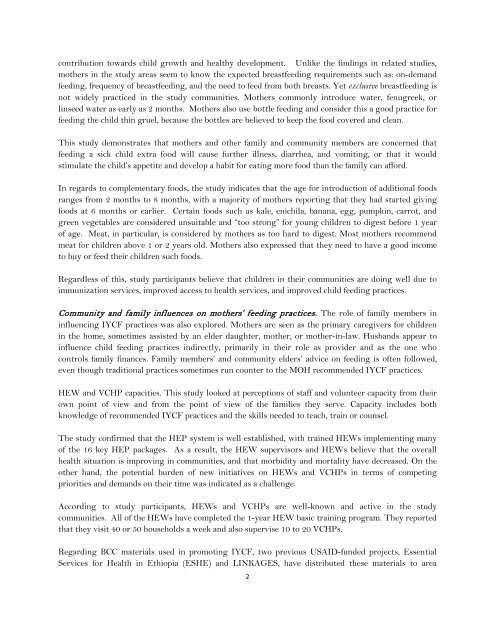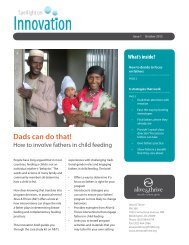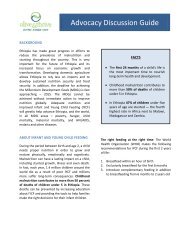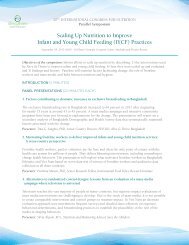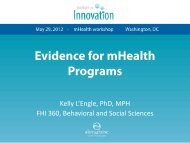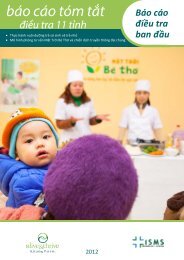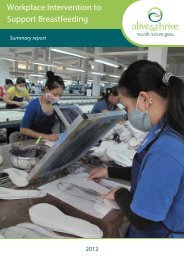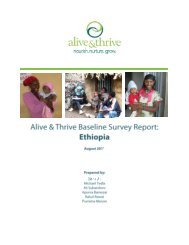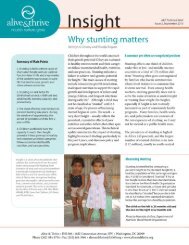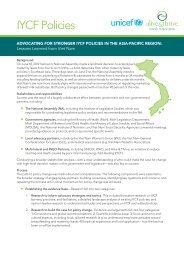IYCF Practices, Beliefs, and Influences in SNNP ... - Alive & Thrive
IYCF Practices, Beliefs, and Influences in SNNP ... - Alive & Thrive
IYCF Practices, Beliefs, and Influences in SNNP ... - Alive & Thrive
You also want an ePaper? Increase the reach of your titles
YUMPU automatically turns print PDFs into web optimized ePapers that Google loves.
contribution towards child growth <strong>and</strong> healthy development. Unlike the f<strong>in</strong>d<strong>in</strong>gs <strong>in</strong> related studies,mothers <strong>in</strong> the study areas seem to know the expected breastfeed<strong>in</strong>g requirements such as: on-dem<strong>and</strong>feed<strong>in</strong>g, frequency of breastfeed<strong>in</strong>g, <strong>and</strong> the need to feed from both breasts. Yet exclusive breastfeed<strong>in</strong>g isnot widely practiced <strong>in</strong> the study communities. Mothers commonly <strong>in</strong>troduce water, fenugreek, orl<strong>in</strong>seed water as early as 2 months. Mothers also use bottle feed<strong>in</strong>g <strong>and</strong> consider this a good practice forfeed<strong>in</strong>g the child th<strong>in</strong> gruel, because the bottles are believed to keep the food covered <strong>and</strong> clean.This study demonstrates that mothers <strong>and</strong> other family <strong>and</strong> community members are concerned thatfeed<strong>in</strong>g a sick child extra food will cause further illness, diarrhea, <strong>and</strong> vomit<strong>in</strong>g, or that it wouldstimulate the child’s appetite <strong>and</strong> develop a habit for eat<strong>in</strong>g more food than the family can afford.In regards to complementary foods, the study <strong>in</strong>dicates that the age for <strong>in</strong>troduction of additional foodsranges from 2 months to 8 months, with a majority of mothers report<strong>in</strong>g that they had started giv<strong>in</strong>gfoods at 6 months or earlier. Certa<strong>in</strong> foods such as kale, enichila, banana, egg, pumpk<strong>in</strong>, carrot, <strong>and</strong>green vegetables are considered unsuitable <strong>and</strong> “too strong” for young children to digest before 1 yearof age. Meat, <strong>in</strong> particular, is considered by mothers as too hard to digest. Most mothers recommendmeat for children above 1 or 2 years old. Mothers also expressed that they need to have a good <strong>in</strong>cometo buy or feed their children such foods.Regardless of this, study participants believe that children <strong>in</strong> their communities are do<strong>in</strong>g well due toimmunization services, improved access to health services, <strong>and</strong> improved child feed<strong>in</strong>g practices.Community <strong>and</strong> family <strong>in</strong>fluences on mothers’ feed<strong>in</strong>g practices. The role of family members <strong>in</strong><strong>in</strong>fluenc<strong>in</strong>g <strong>IYCF</strong> practices was also explored. Mothers are seen as the primary caregivers for children<strong>in</strong> the home, sometimes assisted by an elder daughter, mother, or mother-<strong>in</strong>-law. Husb<strong>and</strong>s appear to<strong>in</strong>fluence child feed<strong>in</strong>g practices <strong>in</strong>directly, primarily <strong>in</strong> their role as provider <strong>and</strong> as the one whocontrols family f<strong>in</strong>ances. Family members’ <strong>and</strong> community elders’ advice on feed<strong>in</strong>g is often followed,even though traditional practices sometimes run counter to the MOH recommended <strong>IYCF</strong> practices.HEW <strong>and</strong> VCHP capacities. This study looked at perceptions of staff <strong>and</strong> volunteer capacity from theirown po<strong>in</strong>t of view <strong>and</strong> from the po<strong>in</strong>t of view of the families they serve. Capacity <strong>in</strong>cludes bothknowledge of recommended <strong>IYCF</strong> practices <strong>and</strong> the skills needed to teach, tra<strong>in</strong> or counsel.The study confirmed that the HEP system is well established, with tra<strong>in</strong>ed HEWs implement<strong>in</strong>g manyof the 16 key HEP packages. As a result, the HEW supervisors <strong>and</strong> HEWs believe that the overallhealth situation is improv<strong>in</strong>g <strong>in</strong> communities, <strong>and</strong> that morbidity <strong>and</strong> mortality have decreased. On theother h<strong>and</strong>, the potential burden of new <strong>in</strong>itiatives on HEWs <strong>and</strong> VCHPs <strong>in</strong> terms of compet<strong>in</strong>gpriorities <strong>and</strong> dem<strong>and</strong>s on their time was <strong>in</strong>dicated as a challenge.Accord<strong>in</strong>g to study participants, HEWs <strong>and</strong> VCHPs are well-known <strong>and</strong> active <strong>in</strong> the studycommunities. All of the HEWs have completed the 1-year HEW basic tra<strong>in</strong><strong>in</strong>g program. They reportedthat they visit 40 or 50 households a week <strong>and</strong> also supervise 10 to 20 VCHPs.Regard<strong>in</strong>g BCC materials used <strong>in</strong> promot<strong>in</strong>g <strong>IYCF</strong>, two previous USAID-funded projects, EssentialServices for Health <strong>in</strong> Ethiopia (ESHE) <strong>and</strong> LINKAGES, have distributed these materials to area2


